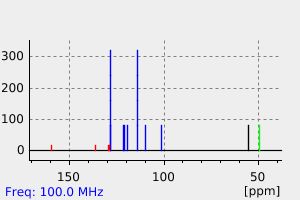1-(4-methoxybenzyl)-1H-indole
中文名称
——
中文别名
——
英文名称
1-(4-methoxybenzyl)-1H-indole
英文别名
1-(p-methoxybenzyl)indole;1-[(4-methoxyphenyl)methyl]indole
CAS
——
化学式
C16H15NO
mdl
MFCD16319762
分子量
237.301
InChiKey
TUSDZZGJRWHYNR-UHFFFAOYSA-N
BEILSTEIN
——
EINECS
——
-
物化性质
-
计算性质
-
ADMET
-
安全信息
-
SDS
-
制备方法与用途
-
上下游信息
-
文献信息
-
表征谱图
-
同类化合物
-
相关功能分类
-
相关结构分类
计算性质
-
辛醇/水分配系数(LogP):3.6
-
重原子数:18
-
可旋转键数:3
-
环数:3.0
-
sp3杂化的碳原子比例:0.125
-
拓扑面积:14.2
-
氢给体数:0
-
氢受体数:1
上下游信息
-
下游产品
中文名称 英文名称 CAS号 化学式 分子量 —— 1-(4-methoxybenzyl)-1H-indole-3-carbaldehyde 928835-08-9 C17H15NO2 265.312
反应信息
-
作为反应物:描述:1-(4-methoxybenzyl)-1H-indole 在 溶剂黄146 作用下, 以 水 、 丙酮 为溶剂, 反应 16.0h, 生成 1-(1-(4-methoxybenzyl)-1H-indol-3-yl)-N,N,N-trimethylmethanaminium iodide参考文献:名称:Novel 1-(1-benzyl-1H-indol-3-yl)-N,N,N-trimethylmethanaminium iodides are competitive antagonists for the human α4β2 and α7 nicotinic acetylcholine receptors摘要:本研究介绍了一系列新型 1-(1-苄基-1H-吲哚-3-基)-N,N,N-三甲基甲铵碘化物衍生物在人类(h)δ±7 和 δ±4δ²2烟碱乙酰胆碱受体(nAChRs)上的合成和药理学特征。这些化合物的抑制活性是通过对表达 hα7 或 hα4β2 nAChR 亚型的细胞进行 Ca2+ 流入试验确定的。为了确定所观察到的抑制活性是由竞争性机制还是非竞争性机制介导的,还使用 [3H]methyllycaconitine、[3H]cytisine 和 [3H]imipramine 进行了额外的放射性配体结合试验。结果表明,这些化合物通过竞争机制抑制了 nAChRs,而且与 hα4β2 nAChR 相比,它们对 hα7 nAChR 的抑制作用更强。苯环上含氧官能团的取代增加了受体的选择性。特别是羟基衍生物 4b 和 4c 对 hδ7 nAChR 亚型的选择性最高。分子对接结果表明,羟基与δ±7-Gln116 处的羰基形成了氢键,而与δ²2-Phe115 处的羰基没有形成氢键,这在分子水平上支持了观察到的受体选择性。DOI:10.1039/c3md00042g
-
作为产物:描述:2-ethynyl-N-(4-methoxybenzyl)aniline 在 copper diacetate 作用下, 以 1,2-二氯乙烷 为溶剂, 反应 48.0h, 以89%的产率得到1-(4-methoxybenzyl)-1H-indole参考文献:名称:Cu(II)盐催化2-乙炔基苯胺衍生物合成吲哚环的有效方法的开发及其在天然产物合成中的应用摘要:研究了Cu(II)盐催化吲哚合成的有效方法的开发及其应用。已经证明,Cu(OAc)2是合成各种1-对甲苯磺酰基或1-甲基磺酰吲哚的最佳催化剂,这些1-对甲苯磺酰基或1-甲基磺酰吲哚在吲哚的芳环和C2位置均具有吸电子和供电子基团。对于初级苯胺衍生物,Cu(OCOCF 3)2表现出良好的活性,而Cu(OAc)2是仲苯胺环化的良好催化剂。该方法可用于在同一分子中具有亲电子部分的化合物的顺序环化反应。通过用KH预先处理,实现了顺序环化以提供三环系统,但第二个环化仅限于五元和六元环。最后,完成了以Cu(II)促进的吲哚合成为关键步骤的马匹的正式和全合成。DOI:10.1021/jo035528b
文献信息
-
Divergent Dehydrogenative Coupling of Indolines with Alcohols作者:Xue Jiang、Weijun Tang、Dong Xue、Jianliang Xiao、Chao WangDOI:10.1021/acscatal.6b03667日期:2017.3.3The dehydrogenative coupling of indolines with alcohols catalyzed by an iridium complex has been achieved to afford both N- and C3-alkylated indoles selectively, by simply changing the addition time of a base additive. The iridacycle catalyst plays multiple roles in these reactions, which dehydrogenates both amines and alcohols and catalyzes the coupling reactions. Mechanistic studies reveal that a
-
Manganese-Catalyzed Regioselective Dehydrogenative C- versus N-Alkylation Enabled by a Solvent Switch: Experiment and Computation作者:Jannik C. Borghs、Viktoriia Zubar、Luis Miguel Azofra、Jan Sklyaruk、Magnus RuepingDOI:10.1021/acs.orglett.0c01270日期:2020.6.5base metal-catalyzed regioselective dehydrogenative alkylation of indolines using readily available alcohols as the alkylating reagent is reported. A single air- and moisture-stable manganese catalyst provides access to either C3- or N-alkylated indoles depending on the solvent used. Mechanistic studies indicate that the reaction takes place through a combined acceptorless dehydrogenation and hydrogen
-
Brønsted Acid-Catalyzed Decarboxylative Redox Amination: Formation of <i>N</i>-Alkylindoles from Azomethine Ylides by Isomerization作者:Hui Mao、Sichang Wang、Peng Yu、Huiqing Lv、Runsheng Xu、Yuanjiang PanDOI:10.1021/jo102218v日期:2011.2.18decarboxylative redox amination involving aldehydes with 2-carboxyindoline for the synthesis of N-alkylindoles is described. The decarboxylative condensations of aldehydes with 2-carboxyindoline produce azomethine ylides in situ, which then transform into N-alkylindoles by isomerization.
-
含嘧啶并三氮唑-吲哚类化合物及其制备方法 和应用
-
Design and synthesis of new indole containing biaryl derivatives as potent antiproliferative agents作者:Shuo Yuan、Si-Qi Feng、An-Qi Li、Jia-Hui Zuo、Dan-Qing Zhang、Yu-Jie Xing、Zhiyu Xie、Bin Yu、Hong-Min LiuDOI:10.1016/j.bioorg.2021.104821日期:2021.5indole containing biaryl derivatives were designed and synthesized, and further biological evaluations of their antiproliferative activity against cancer cell lines (MGC-803 and TE-1 cells) were also conducted. Of these synthesized biaryls, compound 4-methyl-2-((5-methyl-[1,2,4]triazolo[1,5-a]pyrimidin-7-yl)methyl)quinazoline (23) performed as the most potent antiproliferative agent that inhibited cell设计并合成了一系列新的含有吲哚的联芳衍生物,并对其抗癌细胞系(MGC-803 和 TE-1 细胞)的抗增殖活性进行了进一步的生物学评估。在这些合成的联芳基化合物中,化合物 4-methyl-2-((5-methyl-[1,2,4]triazolo[1,5 - a ]pyrimidin-7-yl)methyl)quinazoline ( 23 ) 作为最有效的抑制 MGC-803 细胞活力的抗增殖剂,IC 50值为 8.28 µM。此外,机理研究表明化合物4-甲基-2-((5-甲基-[1,2,4]三唑并[1,5 - a ]嘧啶-7-基)甲基)喹唑啉( 23) 可以抑制 c-Myc 和糖酵解相关蛋白的表达,减少 ATP 和乳酸的产生,并通过激活 AMP 活化蛋白激酶 (AMPK) 和 p53 信号通路进一步诱导细胞凋亡。
表征谱图
-
氢谱1HNMR
-
质谱MS
-
碳谱13CNMR
-
红外IR
-
拉曼Raman
-
峰位数据
-
峰位匹配
-
表征信息
同类化合物
(Z)-3-[[[2,4-二甲基-3-(乙氧羰基)吡咯-5-基]亚甲基]吲哚-2--2-
(S)-(-)-5'-苄氧基苯基卡维地洛
(R)-(+)-5'-苄氧基卡维地洛
(R)-卡洛芬
(N-(Boc)-2-吲哚基)二甲基硅烷醇钠
(E)-2-氰基-3-(5-(2-辛基-7-(4-(对甲苯基)-1,2,3,3a,4,8b-六氢环戊[b]吲哚-7-基)-2H-苯并[d][1,2,3]三唑-4-基)噻吩-2-基)丙烯酸
(4aS,9bR)-6-溴-2,3,4,4a,5,9b-六氢-1H-吡啶并[4,3-B]吲哚
(3Z)-3-(1H-咪唑-5-基亚甲基)-5-甲氧基-1H-吲哚-2-酮
(3Z)-3-[[[4-(二甲基氨基)苯基]亚甲基]-1H-吲哚-2-酮
(3R)-(-)-3-(1-甲基吲哚-3-基)丁酸甲酯
(3-氯-4,5-二氢-1,2-恶唑-5-基)(1,3-二氧代-1,3-二氢-2H-异吲哚-2-基)乙酸
齐多美辛
鸭脚树叶碱
鸭脚木碱,鸡骨常山碱
鲜麦得新糖
高氯酸1,1’-二(十六烷基)-3,3,3’,3’-四甲基吲哚碳菁
马鲁司特
马鞭草(VERBENAOFFICINALIS)提取物
马来酸阿洛司琼
马来酸替加色罗
顺式-ent-他达拉非
顺式-1,3,4,4a,5,9b-六氢-2H-吡啶并[4,3-b]吲哚-2-甲酸乙酯
顺式-(+-)-3,4-二氢-8-氯-4'-甲基-4-(甲基氨基)-螺(苯并(cd)吲哚-5(1H),2'(5'H)-呋喃)-5'-酮
靛青二磺酸二钾盐
靛藍四磺酸
靛红联二甲酚
靛红磺酸钠
靛红磺酸
靛红乙烯硫代缩酮
靛红-7-甲酸甲酯
靛红-5-磺酸钠
靛红-5-磺酸
靛红-5-硫酸钠盐二水
靛红-5-甲酸甲酯
靛红
靛玉红衍生物E804
靛玉红3'-单肟5-磺酸
靛玉红-3'-单肟
靛玉红
靛噻
青色素3联己酸染料,钾盐
雷马曲班
雷莫司琼杂质13
雷莫司琼杂质12
雷莫司琼杂质
雷替尼卜定
雄甾-1,4-二烯-3,17-二酮
阿霉素的代谢产物盐酸盐
阿贝卡尔
阿西美辛杂质3







